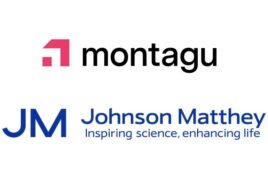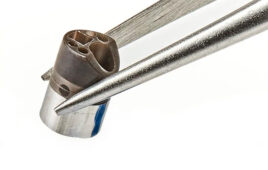Heather Thompson, Senior Editor
As is the case with many medical device industry suppliers, Trelleborg has engaged in a spate of acquisitions to broaden its offerings and better serve the growing needs of its OEM customers.Last year, Trelleborg, Sweden–based Trelleborg announced the acquisition of Tustin, California–based Specialty Silicone Fabricators. They’ve made three other acquisitions over the past year to better serve customers in medtech as well as other areas: New Berlin, Wisconsin–based Anderson Seal, an El Segundo, California-based subsidiary of CoorsTek, and Charlotte, North Carolina–based distributor Carolina Seal.
We caught up with Trelleborg representatives this week at the annual MD&M West conference and expo in Anaheim, California, where they’re exhibiting at Booth #1605, and asked them how the mergers are going. (There was also some talk about OEM cost containment and drug device combination products.)
Here’s what Drew Rogers, Trelleborg’s global segment director for healthcare and medicine, and Tony O’Neil, manager of marketing communications, had to say:
MDO: I’ve had four interviews today, and you’re the third that is at that point where you’ve made the acquisition and you’re in the process of discovering and working through how to bring everything together. How to bring those families together and make that leap to the market?
O’Neil: We have a process internally called a hundred in a hundred— a hundred tasks in a hundred days. It’s broken down by different departments, so I’m responsible for marketing and communications.
It’s tactical and strategic: tactical from a standpoint, make sure the website and the literature and stuff looks Trelleborg, strategic, how are we going to get this stuff to market and start commercializing and leveraging the purchase. Trelleborg moves pretty quickly from that standpoint, because we have to. It’s a mandate, and it’s closely watched.
MDO: So what are the exciting things that you’re doing on the medical side that you wanted to talk about today?
Rogers: As the name suggests, Specialty Silicon Fabricating is a company that does all sorts of fabrication. Very unique, a lot of it’s custom, built to spec, a lot of innovation. … Just the opportunity to promote these unique capabilities of SSF on a broader scale, that represents significant growth.
The other thing that is beneficial is that the synergy between what was Trelleborg Healthcare and Medical, and then with the addition of SSF. Both companies are long on engineering—a lot of innovation, a lot of development. We work with our customers to develop solutions. Trelleborg brings automated manufacturing … stuff that SSF could never compete with. SSF, on the other hand, brings the early stage design and development assistance and rapid prototyping. [SSF sort of gets] companies into the first and second year of production, which was not a strength of Trelleborg.
When you marry those two together, you really have a full spectrum of services. And so, without doing anything other than, as you were talking about, weaving the companies together, just by doing that, we’ll get exponential increases just out of each of the two entities now that they’ve combined.
MDO: What are some of the trends that you’re seeing from your customer that you’re trying to address?
Rogers: I think that, overall, they’re looking to contain costs. Which, is not new but, I think it’s-
MDO: Feels more urgent now.
Rogers: Yeah, it does. I think that the interesting thing is that it’s not that they’re coming to us necessarily saying, “Cut your price, cut your margins.” They’re saying, “Develop more efficient techniques.” We can combine. We can drive costs down. It’s funny because you have this stereotype of … people and purchasing agents saying, “Cut my price, cut my price, cut my price.” Really what they’re saying is, “Collaborate with me to drive costs down, and let’s both share in that.” It’s a good mandate, and it’s one that can be solved with technology just as much as it is cutting corners or cutting margins. That’s been a trend.
MDO: Anything else?
Rogers: There’s been a trend in the device industry to develop drug-device combination products. I’m not talking about a syringe to deliver product. I’m not even really talking about a patch. … I’m really talking about a device that will already [be] in the body, it’s implanted for some other reason. It’s a catheter tube, it’s a drain, it’s a lead wire. Already inside the body, but now they want it to also do drug delivery. In essence, they’re saying, “Hey, these intrusive tubings that used to cause infections, let’s make them part of the solution instead of part of the problem.” We at SSF grabbed onto that five years ago, and really got out ahead of the wagon train when it comes to those types of devices.
Fortunately for us, silicone is a marvelous vehicle for revolution, because of the properties it has. One, it’s biologically inert, so you can put it in the body and the human body doesn’t react and try to drive it out. In addition, if you can vary the durometer of the material, the strength of the drug, and the amount of time to submerge it, you can control dilution rates. If you came to me and said, “I want my drain to elute an antimicrobial, and I want it to elute at this rate, for this amount of time.” We can do that, because silicone is so stable. Once you get one tube to do it, that formula will work on every tube that you do.
What the beauty of that, if I bring it all closer to home, before Trelleborg got SSF, SSF had very limited means. To promote drug-device combination products, [SSF] needed to stay close to home. We needed to sell right back to our existing customers with something that they could use. We didn’t have a salesperson to call [on] the phone and say, “Hey.” Now, at Trelleborg, we see it really exploding. … [You take] the pharma companies who have the drugs, and most of them don’t have manufacturing. If they do, it’s not licensed to handle the drugs. We’ve got this opportunity to market this to huge markets, way beyond what SSF did. It is one of the biggest areas for growth in the next 2 to 5 years.
Managing editor Chris Newmarker contributed to this report.
[Want to stay more on top of MDO content? Subscribe to our weekly e-newsletter.]





